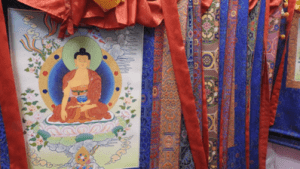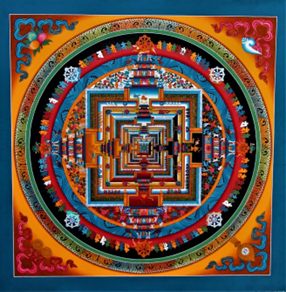TAG: GS 1: ART AND CULTURE
THE CONTEXT: Recently, efforts has been made to raise awareness about Thangka art underway at Delhi’s Majnu Ka Tila.
EXPLANATION:
- As one enters the Samyeling Tibetan settlement in Majnu Ka Tila, Delhi, one shop immediately captures attention with its exquisite display of Thangka art.
- The serene figure of Avalokiteśvara (Chenrezig in Tibetan) gazes compassionately from the showcase, painted on silk fabric with breathtaking details in gold leaf.
- This piece is more than just art; it is a representation of cultural identity for the 2,500 Tibetans residing in Majnu Ka Tila.
 Thangka art at Majnu Ka Tila
Thangka art at Majnu Ka Tila
Historical and Cultural Significance
- Origins and Preservation
- The shop serves as a hub for preserving and promoting Thangka art.
- It was established approximately five decades ago following the 1959 Tibetan uprising.
- After Tibetans fled to India and received asylum, efforts were made to maintain this traditional art form, with artists from Tibet and Nepal contributing to its preservation.
- The Artistic Process
- Thangka paintings are created on rich cotton or silk applique and depict Buddhist deities, influential Lamas, and the life story of Buddha.
- These intricate pieces use water-soluble animal glue, derived from minerals and organic materials, for their paints.
- In Nepal, 24-carat gold is often applied to enhance the artwork’s sublimity.
- The production process is deeply spiritual, involving purification rituals and mantra recitations.
- Modern Adaptations
- Contemporary Thangka artists now incorporate modern themes, such as mandalas, to appeal to a global audience.
- Despite the rise of printed reproductions, which are mass-produced for devotional and decorative purposes, the traditional handmade Thangka remains a prized and valuable art form.

 Thangka art
Thangka art
Economic and Social Impact
- Market Dynamics
- The Thangka art market ranges from mass-produced replicas costing between ₹1,000 and ₹10,000 to authentic handcrafted pieces starting from ₹10,000 and going up to ₹10 lakh.
- Factors influencing the cost include the size, material, complexity, the artist’s seniority, and the age of the Thangka.
- Empowerment Through Art
- In the Himalayas and Majnu Ka Tila, teaching Thangka art empowers communities by providing training and employment opportunities.
- This initiative not only preserves Tibetan culture but also supports local livelihoods.
Challenges and Resilience
- According to author of “Declining Crafts: Looking Through a Different Perspective,” Thangka art remains resilient despite industrialization, commercialization, and mass production.
- Unlike India’s Madhubani art, which has seen a decline in quality due to non-traditional color schemes, Thangka art continues to uphold traditional production methods.
Cultural Context
- Heritage and History
- Majnu Ka Tila, also known as Little Lhasa, is steeped in Tibetan heritage and history.
- It is named after Abdulla, also known as Majnu, who, seeking the true meaning of God, ferried people across the Yamuna for free and was blessed by Guru Nanak.
- The area also hosts a gurudwara built by Baghel Singh in 1783, adding to its historical significance.
- Promoting Tibetan Culture
- Thangka paintings in Majnu Ka Tila contextualize Tibetan culture and history for every visitor.
- Lakkhi, who manages the shop, emphasizes the importance of connecting people with the artists to promote Tibetan culture and heritage.

